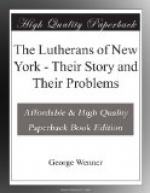EPILOGUE
One seldom finds an epilogue in a book nowadays. Its purpose in the drama was to explain to the audience the meaning of the play. It does not speak well for a writer if the people miss the point of his essay. But it is just like a preacher to say something “in conclusion” to secure, if possible, the hesitating assent of some hearer.
We have reached the 20th century. We are looking back upon 270 years of history on Manhattun Island. What we have done and what we have left undone is recorded in the stereotyped pages of an unchanging past. Our successes and our failures are the chapters from which we may learn lessons for the future. The gates of that future are open to us now.
Where Arensius and Falckner ministered to a feeble flock under inconceivable difficulties, there is built the greatest, certainly the largest, city of the world. From all the races and tongues of the earth men are gathering here to solve the problems of their lives. From Lutheran lands fifty myriads have already come and are living within our walls. Consciously or otherwise they appeal to us, their brethren in the faith, for that religious fellowship for which every man sometimes longs. If we do not respond, who shall interpret for them the religious life and questions of the new world?
From these Lutheran lands, from Scandinavia to the Balkan peninsula, from the Rhine to the Ural Mountains, other myriads will come in the long years that will follow the war. New history is sure to be written for Europe and America. What shall be our contribution to its unwritten pages?
In solving the problems that confront us we shall at the same time help to solve the problems of our city and of our country. The simple faith and the catholic principles of our church should secure far us a wide field of useful and effective service.
APPENDIX
Abbreviations
Synods — Min., Ministerium of New York; Mo.,
Missouri; N. Y., New York; N. E., New York and New
England; Aug., Swedish Augustana; Nor., Norwegian;
Fin., National Church of Finland; Pa., Pennsylvania;
O.,Ohio;
D., Danish; Suo., Suomi (Finnish); U.D., United Danish;
Ap., Apostolic (Finnish); NN., National Church of
Norway.
Languages — G., German; E., English; S., Swedish; N., Norwegian; F., Finnish; D., Danish; Sl., Slovak, Bohemian and Magyar; Let., Lettish; Est., Esthonian; Pol., Polish; Y,, Yiddish; It., Italian; Lith., Lithuanian.
Heads of Statistical Columns — Lang., Language; Date, Date of Organization; Syn., Synodical connection of congregation or pastor; Comm., Number of communicants; Souls, Number of baptized persons related to the congregation; Syn., Synodical connection of pastor or congregation; P. S., Pupils in Parochial School; S. S., Pupils in Sunday School; W. S., Pupils receiving instruction in religion on weekdays [tr. note: in the table, this column is headed “R.H."]; Prop., Net value of real estate in terms of a thousand dollars.




